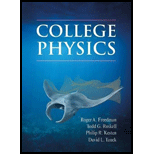
COLLEGE PHYSICS
2nd Edition
ISBN: 9781464196393
Author: Freedman
Publisher: MAC HIGHER
expand_more
expand_more
format_list_bulleted
Concept explainers
Question
Chapter 26, Problem 51QAP
To determine
(a)
The momentum of a photon having wavelength of 550 nm
To determine
(b)
The momentum of the photon is of wavelength
Expert Solution & Answer
Want to see the full answer?
Check out a sample textbook solution
Students have asked these similar questions
Can someone help me with this question. Thanks.
Can someone help me with this question. Thanks.
Can someone help me with this question. Thanks.
Chapter 26 Solutions
COLLEGE PHYSICS
Ch. 26 - Prob. 1QAPCh. 26 - Prob. 2QAPCh. 26 - Prob. 3QAPCh. 26 - Prob. 4QAPCh. 26 - Prob. 5QAPCh. 26 - Prob. 6QAPCh. 26 - Prob. 7QAPCh. 26 - Prob. 8QAPCh. 26 - Prob. 9QAPCh. 26 - Prob. 10QAP
Ch. 26 - Prob. 11QAPCh. 26 - Prob. 12QAPCh. 26 - Prob. 13QAPCh. 26 - Prob. 14QAPCh. 26 - Prob. 15QAPCh. 26 - Prob. 16QAPCh. 26 - Prob. 17QAPCh. 26 - Prob. 18QAPCh. 26 - Prob. 19QAPCh. 26 - Prob. 20QAPCh. 26 - Prob. 21QAPCh. 26 - Prob. 22QAPCh. 26 - Prob. 23QAPCh. 26 - Prob. 24QAPCh. 26 - Prob. 25QAPCh. 26 - Prob. 26QAPCh. 26 - Prob. 27QAPCh. 26 - Prob. 28QAPCh. 26 - Prob. 29QAPCh. 26 - Prob. 30QAPCh. 26 - Prob. 31QAPCh. 26 - Prob. 32QAPCh. 26 - Prob. 33QAPCh. 26 - Prob. 34QAPCh. 26 - Prob. 35QAPCh. 26 - Prob. 36QAPCh. 26 - Prob. 37QAPCh. 26 - Prob. 38QAPCh. 26 - Prob. 39QAPCh. 26 - Prob. 40QAPCh. 26 - Prob. 41QAPCh. 26 - Prob. 42QAPCh. 26 - Prob. 43QAPCh. 26 - Prob. 44QAPCh. 26 - Prob. 45QAPCh. 26 - Prob. 46QAPCh. 26 - Prob. 47QAPCh. 26 - Prob. 48QAPCh. 26 - Prob. 49QAPCh. 26 - Prob. 50QAPCh. 26 - Prob. 51QAPCh. 26 - Prob. 52QAPCh. 26 - Prob. 53QAPCh. 26 - Prob. 54QAPCh. 26 - Prob. 55QAPCh. 26 - Prob. 56QAPCh. 26 - Prob. 57QAPCh. 26 - Prob. 58QAPCh. 26 - Prob. 59QAPCh. 26 - Prob. 60QAPCh. 26 - Prob. 61QAPCh. 26 - Prob. 62QAPCh. 26 - Prob. 63QAPCh. 26 - Prob. 64QAPCh. 26 - Prob. 65QAPCh. 26 - Prob. 66QAPCh. 26 - Prob. 67QAPCh. 26 - Prob. 68QAPCh. 26 - Prob. 69QAPCh. 26 - Prob. 70QAPCh. 26 - Prob. 71QAPCh. 26 - Prob. 72QAPCh. 26 - Prob. 73QAPCh. 26 - Prob. 74QAPCh. 26 - Prob. 75QAPCh. 26 - Prob. 76QAPCh. 26 - Prob. 77QAPCh. 26 - Prob. 78QAPCh. 26 - Prob. 79QAPCh. 26 - Prob. 80QAPCh. 26 - Prob. 81QAPCh. 26 - Prob. 82QAPCh. 26 - Prob. 83QAPCh. 26 - Prob. 84QAPCh. 26 - Prob. 85QAPCh. 26 - Prob. 86QAPCh. 26 - Prob. 87QAPCh. 26 - Prob. 88QAPCh. 26 - Prob. 89QAPCh. 26 - Prob. 90QAPCh. 26 - Prob. 91QAPCh. 26 - Prob. 92QAPCh. 26 - Prob. 93QAPCh. 26 - Prob. 94QAPCh. 26 - Prob. 95QAPCh. 26 - Prob. 96QAPCh. 26 - Prob. 97QAPCh. 26 - Prob. 98QAPCh. 26 - Prob. 99QAPCh. 26 - Prob. 100QAPCh. 26 - Prob. 101QAPCh. 26 - Prob. 102QAPCh. 26 - Prob. 103QAPCh. 26 - Prob. 104QAP
Knowledge Booster
Learn more about
Need a deep-dive on the concept behind this application? Look no further. Learn more about this topic, physics and related others by exploring similar questions and additional content below.Similar questions
- Identical rays of light enter three transparent blocks composed of different materials. Light slows down upon entering the blocks.arrow_forwardFor single-slit diffraction, calculate the first three values of (the total phase difference between rays from each edge of the slit) that produce subsidiary maxima by a) using the phasor model, b) setting dr = 0, where I is given by, I = Io (sin (10) ². 2arrow_forwardA capacitor with a capacitance of C = 5.95×10−5 F is charged by connecting it to a 12.5 −V battery. The capacitor is then disconnected from the battery and connected across an inductor with an inductance of L = 1.55 H . (D)What is the charge on the capacitor 0.0235 s after the connection to the inductor is made? Interpret the sign of your answer. (e) At the time given in part (d), what is the current in the inductor? Interpret the sign of your answer. (f) Atthe time given in part (d), how much electrical energy is stored in the capacitor and how much is stored in the inductor?arrow_forward
arrow_back_ios
SEE MORE QUESTIONS
arrow_forward_ios
Recommended textbooks for you
 College PhysicsPhysicsISBN:9781938168000Author:Paul Peter Urone, Roger HinrichsPublisher:OpenStax College
College PhysicsPhysicsISBN:9781938168000Author:Paul Peter Urone, Roger HinrichsPublisher:OpenStax College College PhysicsPhysicsISBN:9781305952300Author:Raymond A. Serway, Chris VuillePublisher:Cengage Learning
College PhysicsPhysicsISBN:9781305952300Author:Raymond A. Serway, Chris VuillePublisher:Cengage Learning College PhysicsPhysicsISBN:9781285737027Author:Raymond A. Serway, Chris VuillePublisher:Cengage Learning
College PhysicsPhysicsISBN:9781285737027Author:Raymond A. Serway, Chris VuillePublisher:Cengage Learning Physics for Scientists and Engineers with Modern ...PhysicsISBN:9781337553292Author:Raymond A. Serway, John W. JewettPublisher:Cengage Learning
Physics for Scientists and Engineers with Modern ...PhysicsISBN:9781337553292Author:Raymond A. Serway, John W. JewettPublisher:Cengage Learning University Physics Volume 3PhysicsISBN:9781938168185Author:William Moebs, Jeff SannyPublisher:OpenStax
University Physics Volume 3PhysicsISBN:9781938168185Author:William Moebs, Jeff SannyPublisher:OpenStax Modern PhysicsPhysicsISBN:9781111794378Author:Raymond A. Serway, Clement J. Moses, Curt A. MoyerPublisher:Cengage Learning
Modern PhysicsPhysicsISBN:9781111794378Author:Raymond A. Serway, Clement J. Moses, Curt A. MoyerPublisher:Cengage Learning

College Physics
Physics
ISBN:9781938168000
Author:Paul Peter Urone, Roger Hinrichs
Publisher:OpenStax College

College Physics
Physics
ISBN:9781305952300
Author:Raymond A. Serway, Chris Vuille
Publisher:Cengage Learning

College Physics
Physics
ISBN:9781285737027
Author:Raymond A. Serway, Chris Vuille
Publisher:Cengage Learning

Physics for Scientists and Engineers with Modern ...
Physics
ISBN:9781337553292
Author:Raymond A. Serway, John W. Jewett
Publisher:Cengage Learning

University Physics Volume 3
Physics
ISBN:9781938168185
Author:William Moebs, Jeff Sanny
Publisher:OpenStax

Modern Physics
Physics
ISBN:9781111794378
Author:Raymond A. Serway, Clement J. Moses, Curt A. Moyer
Publisher:Cengage Learning